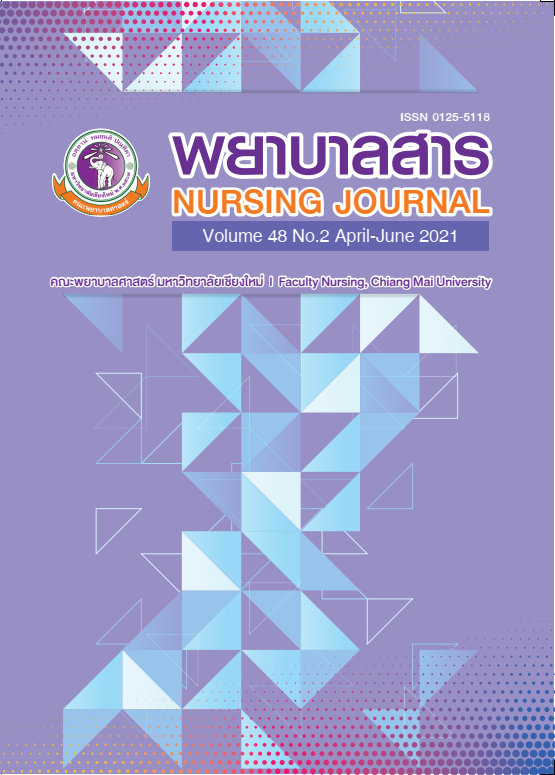Implementation and Barriers in Prevention of Multidrug-Resistant Organisms Transmission Among Community Hospitals
Keywords:
Multidrug-resistant organisms, Implementation, Barriers, Prevention, Community hospitalsAbstract
Healthcare-associated infections caused by multidrug resistant organisms (MDROs) have been steadily increasing. Implementation of MDRO transmission prevention in hospitals is necessary. The purpose of this descriptive study was to determine the implementations and barriers of MDRO transmission prevention in community hospitals. The study sample included 182 infection control nurses in community hospitals. Data were collected from October to December 2017. The research instrument was a questionnaire consisting of four parts: participant background information, hospital information, MDRO transmission prevention implementations, and MDRO transmission prevention barriers. The content validity of the questionnaire was examined by six experts with the content validity index of 0.97 and 0.98 for the implementation and barrier sections. The reliability of the implementation and barriers part were 0.94 and 0.95, respectively. Data were analyzed using descriptive statistics.
Research findings revealed that the activities that had at least 80% implementation by community hospitals were environment control (94.1%), isolation precautions (90.4%), disinfection and sterilization (87.4%) and referral systems (87.4%). The activities that had less than 80% implementation rate included education for healthcare workers, patients and their relatives (79.4%), specimen collection (78.6%), appropriate antimicrobial use (66.8%), MDRO surveillance (65.4%), administrative support (64.9%), and communication (60.0%). The greatest barriers in implementing MDRO transmission precautions were personnel (37.7%), followed by budget (35.6%), materials (34.0%) and administrative (32.7%).
The research results indicated the necessity of encouraging community hospitals to improve MDRO transmission prevention, especially in activities which are implemented less frequently. More support is needed to help community hospitals prevent MDRO transmission more effectively.
References
Bhatia, R. (2011). The burgeoning challenge of antimicrobial resistance. Regional Health Forum. 15(1), 5-8.
Jamsangtong, M. (2015). Implementation of multidrug resistant bacteria transmission prevention among regional hospitals. (Master’s thesis) Faculty of Nursing, Chiang Mai University (In Thai)
Molton, J. S., Tambyah, P. A., Ang, B. S., Ling, M. L., & Fisher, D. A. (2013). The global spread of healthcare-associated multidrug-resistant bacteria: A perspective from Asia. Clinical infectious diseases, 56(9), 1310-1318.
National Antimicrobrial Resistant Surveillance Thailand. (2017). Antimicrobail Resistance Situation 2001-2017. Retrieve from http://narst.dmsc.moph.go.th/news 001.thml
New Hampshire Communicable Disease Epidemic Control Committee. (2015). Recommendations for the Prevention and Control of Multidrug-Resistant Organisms (MDROs) and Clostridium difficile Infection (DCI) for Healthcare Agencies and Community Setting. Retrieve from https://www. dhhs.nh.gov> hai > mdro
Phumart, P., Phodha, T., Thamlikitkul, V., Riewpaiboon, A., Prakongsai, P., & Limwattananon, S. (2012). Health and economic impacts of antimicrobial resistant infection in Thailand. Journal of Health System Research. 6(3), 352-360. (In Thai)
Safdar, N., Sengupta, S., Musuuza, J. S., Juthani-Mehta, M., Drees, M., Abbo, L. M., ... & Morgan, D. J. (2016). Status of the prevention of multidrug-resistant organisms in international settings: A Survey of the Society for Healthcare Epidemiology of America Research Network. Infection Control & Hospital Epidemiology, 38(1), 53-60. doi: 10.1017/ice.2016.242
Weinstein, R. A. (2011). Staphylococcus aureus bacteremia and endocarditis: Marking and impact on outcome. Infection Diseases in Clinical Practice, 19(4), 238-242.
World Health Organization. (2012). The evolving threat of antimicrobial resistance: Options for action. Retrieve from http://www.who.int/patientsafty/implementation/amr/publication/en/
Downloads
Published
How to Cite
Issue
Section
License
บทความที่ได้รับการตีพิมพ์เป็นลิขสิทธิ์ของวารสารพยาบาลสาร
ข้อความที่ปรากฏในบทความแต่ละเรื่องในวารสารวิชาการเล่มนี้เป็นความคิดเห็นส่วนตัวของผู้เขียนแต่ละท่านไม่เกี่ยวข้องกับมหาวิทยาลัยเชียงใหม่ และคณาจารย์ท่านอื่นๆในมหาวิทยาลัยฯ แต่อย่างใด ความรับผิดชอบองค์ประกอบทั้งหมดของบทความแต่ละเรื่องเป็นของผู้เขียนแต่ละท่าน หากมีความผิดพลาดใด ๆ ผู้เขียนแต่ละท่านจะรับผิดชอบบทความของตนเองแต่ผู้เดียว






